Nobody can predict this election. Here’s why.
By almost any measure, 2020 is a very different kind of election.
A pandemic. A recession. Social protests in multiple cities that are entering their fourth month. Record numbers out of work, and record highs in the stock market. Social distancing in offices, restaurants, even in some homes. The oldest nominee in history. A president talking about ignoring the results.
I’ve made my share of election forecasts. But nearly everything about this race is so different, which should make everyone think twice about their assumptions as the voting begins. Here are seven factors that make it extremely difficult to predict what’s going to happen in November:
1
It’s been 100 years since we’ve held a mid-pandemic election. It’s impossible to know how voters will react.

United States
Other G-7 countries
Deaths
per million people
New cases
per million people
Source: Our World in Data
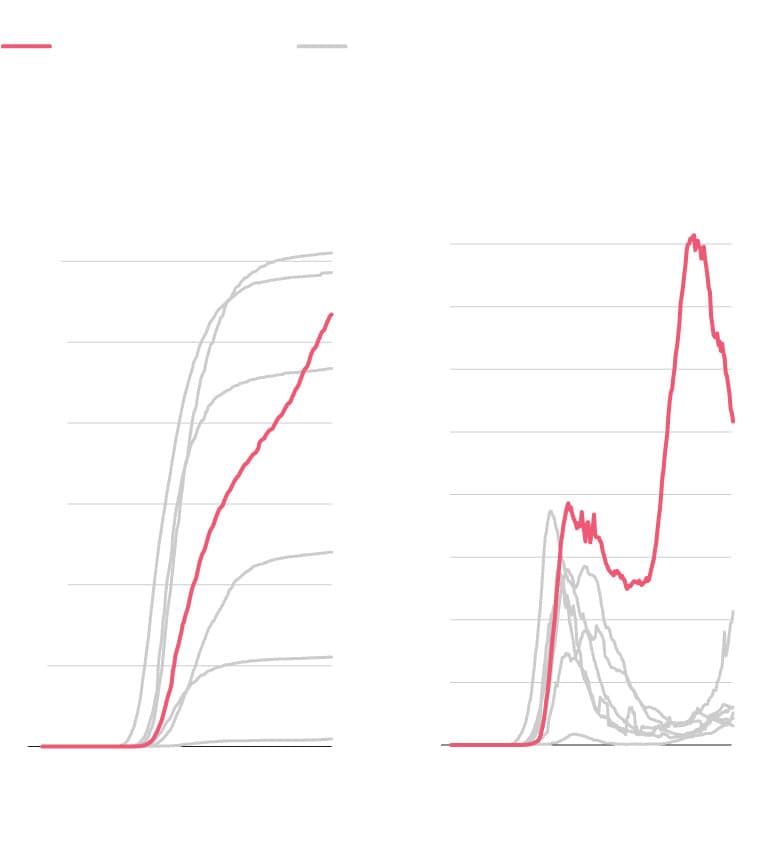
United States
Other G-7 countries
Deaths
per million people
New cases
per million people
Source: Our World in Data
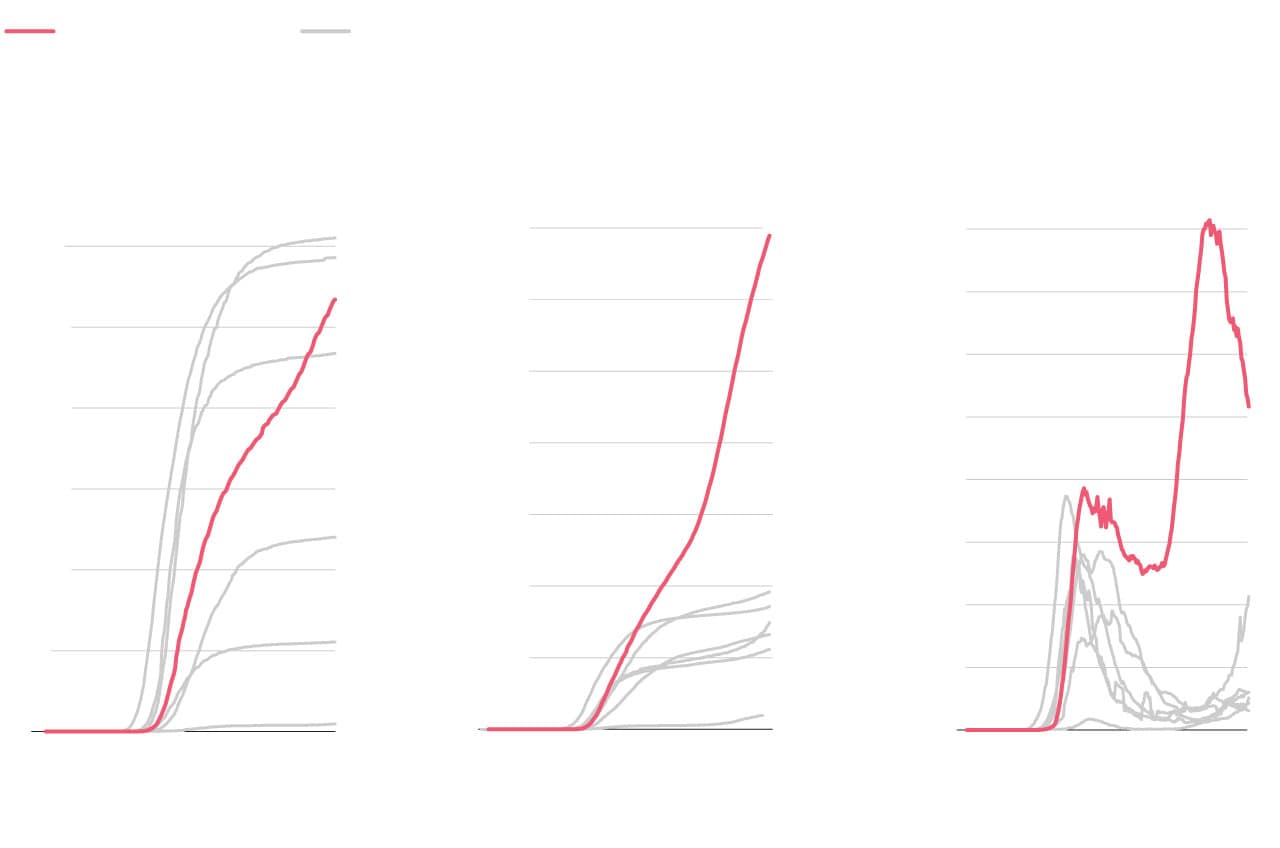
United States
Other G-7 countries
Deaths
per million people
Cases
per million people
New cases
per million people
Source: Our World in Data
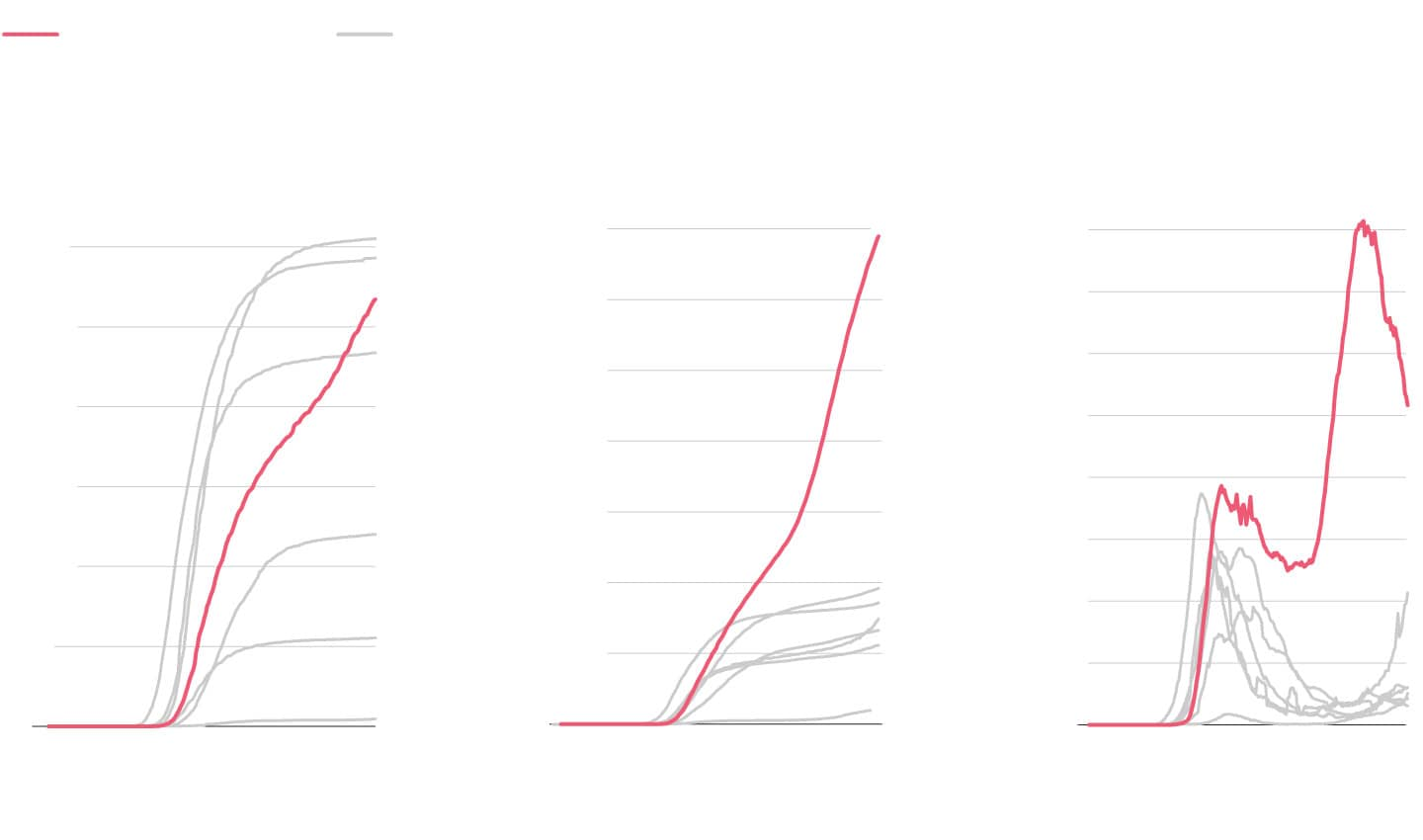
United States
Other G-7 countries
Deaths
per million people
Cases
per million people
New cases
per million people
Source: Our World in Data

How the U.S. compares to other G-7 countries
Deaths per million people
Cases per million people
New cases per million people
United
States
United
States
United States
Other G-7
countries
Other G-7
countries
Source: Our World in Data
Covid-19 has taken an unprecedented toll on the people of the United States. According to Centers for Disease Control and Prevention estimates, more than 5 million people have tested positive for the novel coronavirus; and the death toll may surpass 200,000 in September. Hospitalizations are up in many places, and as the caseload increases, many more cities and counties will struggle to deal with a new wave of sickness and death.
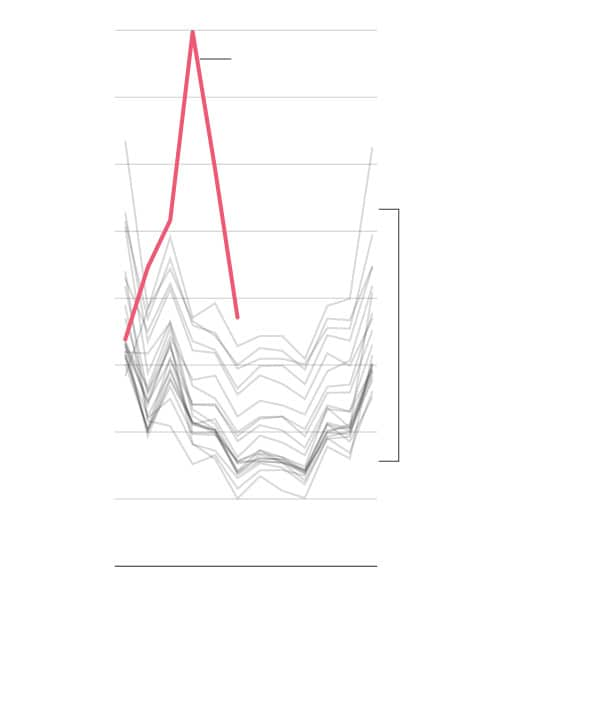
Monthly deaths in 2020
This is likely an underestimate, as death counts come in slowly.
Monthly deaths
registered from
1999 to 2019
Sources: Centers for Disease Control,
National Center for Health Statistics

Monthly deaths in 2020
This is likely an underestimate, as death counts come in slowly.
Monthly deaths
registered from
1999 to 2019
Sources: Centers for Disease Control, National Center
for Health Statistics
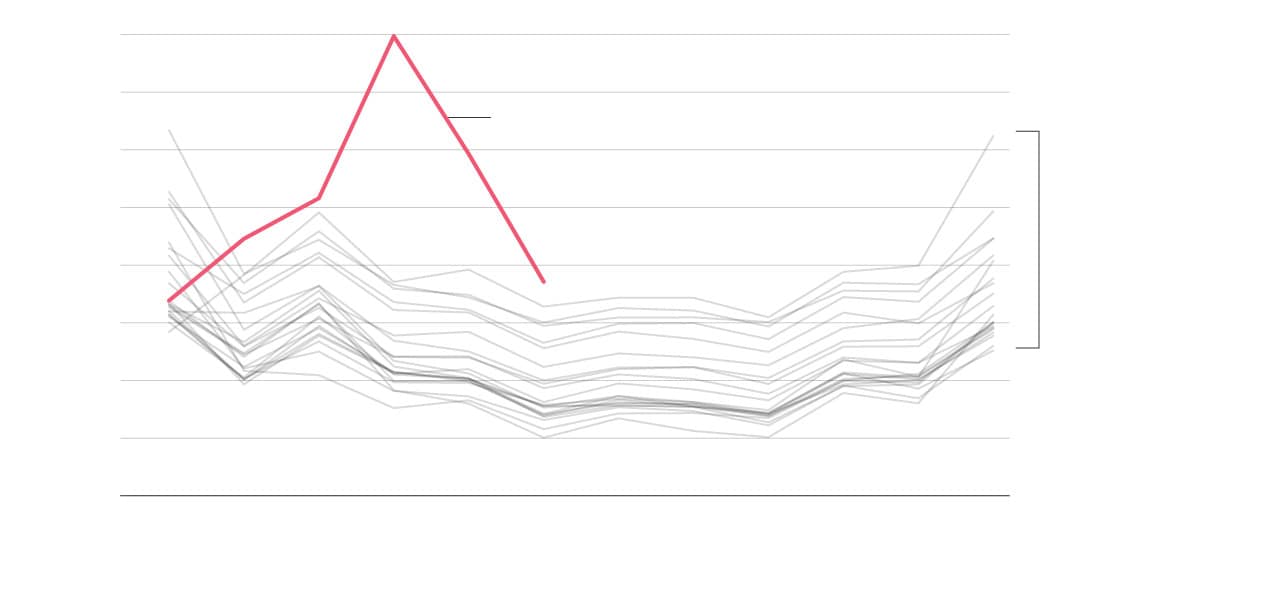
Monthly deaths in 2020
This is likely an underestimate, as death counts come in slowly.
Monthly deaths
registered from
1999 to 2019
Sources: Centers for Disease Control, National Center for Health Statistics
The pandemic has exacted a psychological price. Roughly two-thirds of all Americans are worried that they or someone in their family will be exposed to the virus. The virus is omnipresent: It colors every conversation and dominates daily life.
2
The coronavirus has damaged the economy, and a damaged economy is usually bad for incumbents.

The highest unemployment rate in decades
14.7%
May, 2020
10.2%
July,
2020
Great Recession
Source: Federal Reserve Bank of St. Louis
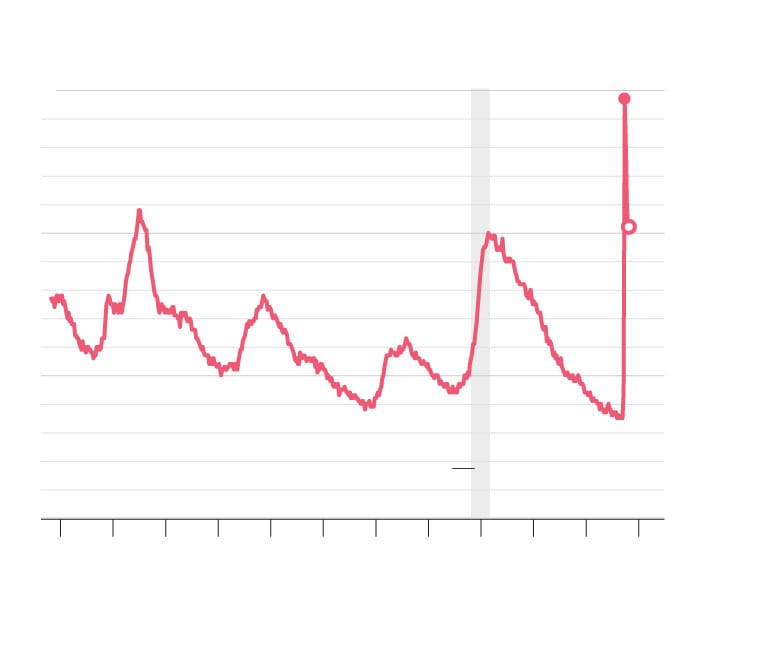
The highest unemployment rate in decades
14.7%
May, 2020
10.2%
July,
2020
Great Recession
Source: Federal Reserve Bank of St. Louis
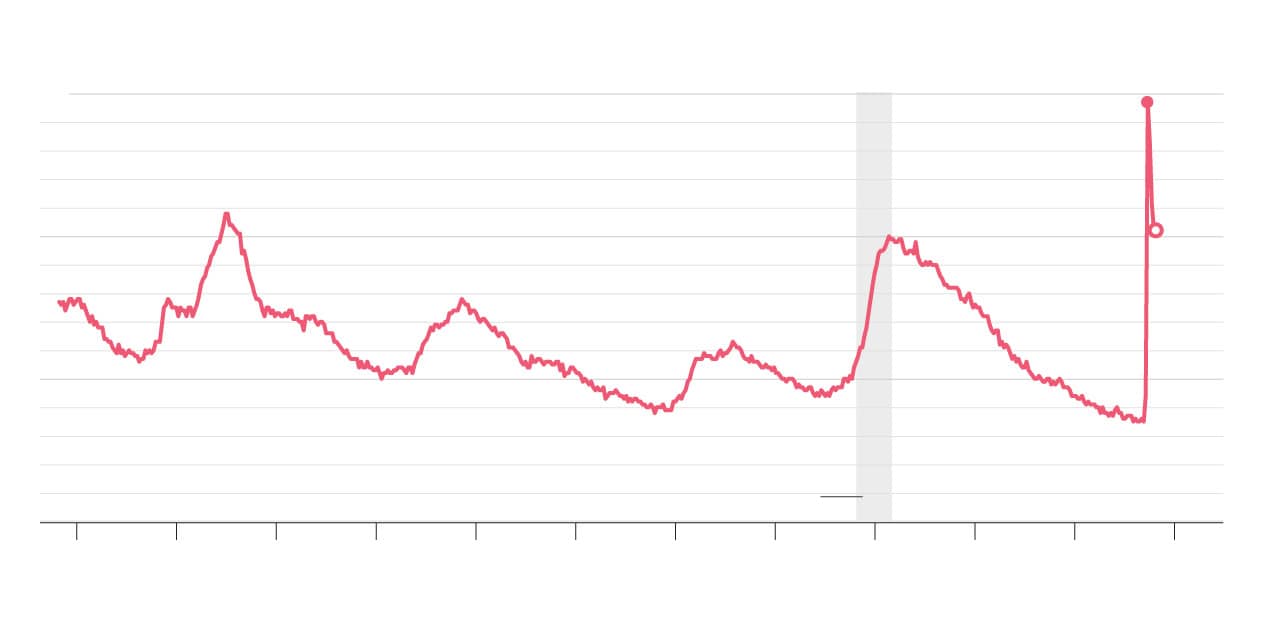
The highest unemployment rate in decades
14.7%
May, 2020
10.2%
July,
2020
Great Recession
Source: Federal Reserve Bank of St. Louis
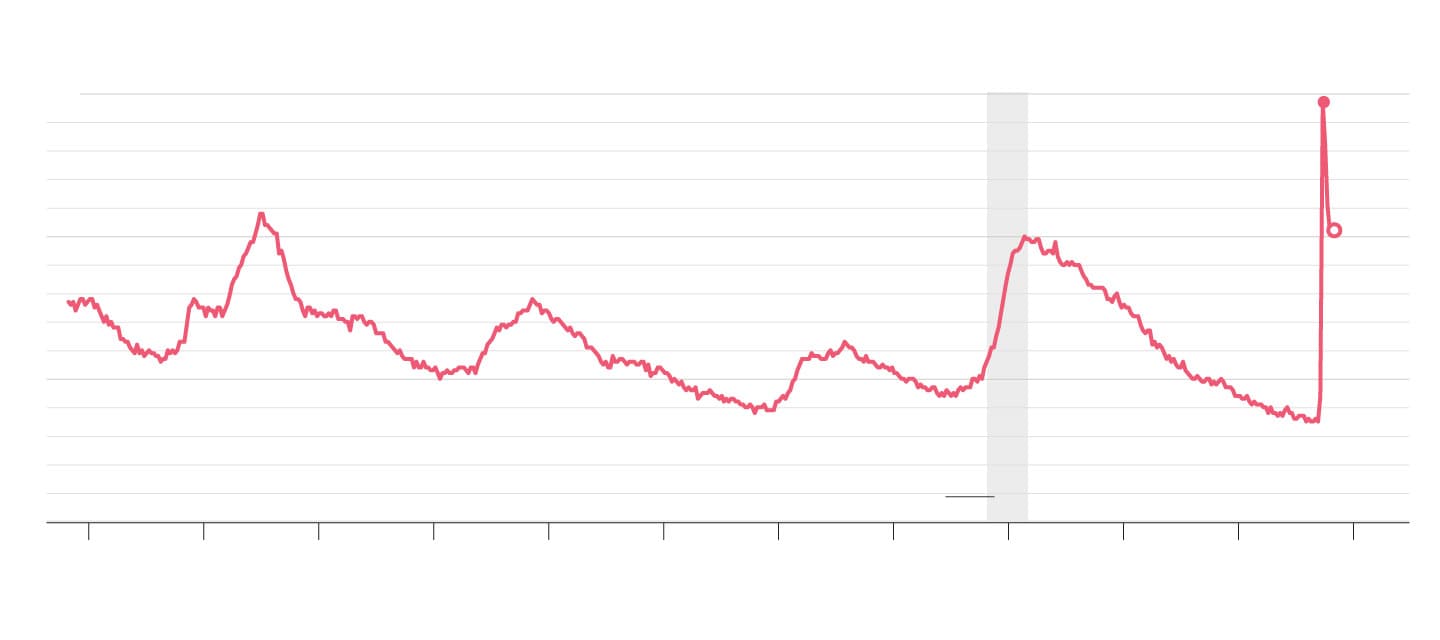
The highest unemployment rate in decades
14.7%
May, 2020
10.2%
July,
2020
Great Recession
Source: Federal Reserve Bank of St. Louis

The highest unemployment rate in decades
14.7%
May, 2020
10.2%
July,
2020
Great Recession
Source: Federal Reserve Bank of St. Louis
The pandemic has also done incalculable damage to the economy. As soon as lockdowns began, the unemployment rate increased by 10 percentage points. It has decreased somewhat since, but the damage is lasting: Many retail businesses across the country are operating at only partial capacity, and entire industries may never recover.
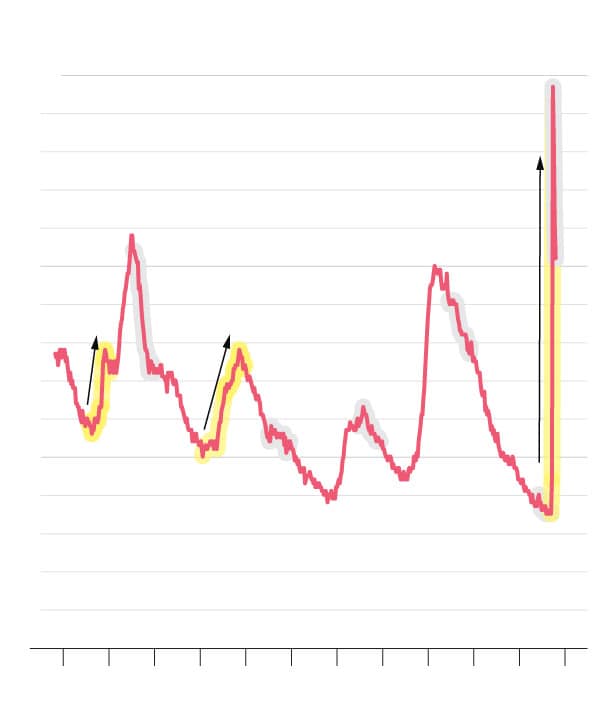
Unemployment rate before elections
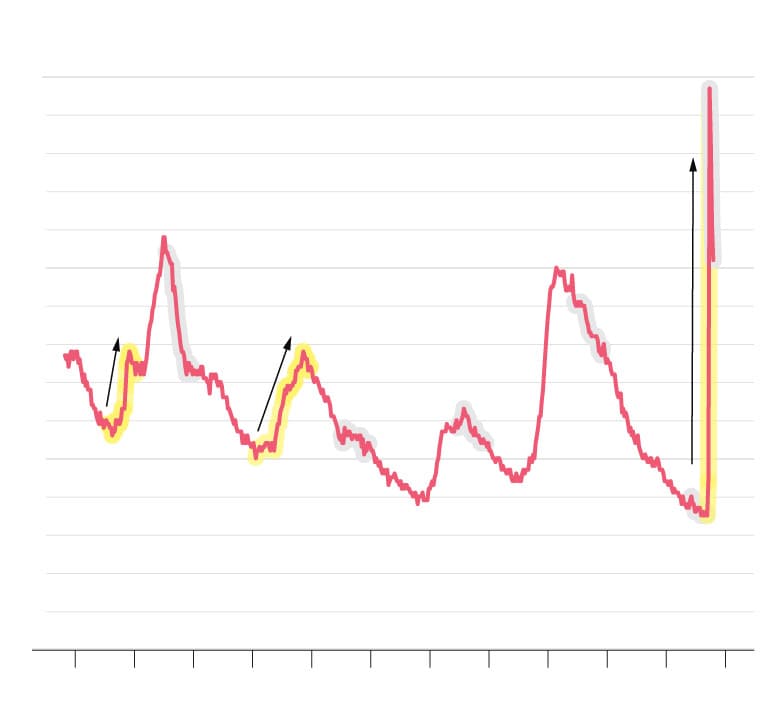
Unemployment rate before elections

Unemployment rate before elections

Unemployment rate before elections
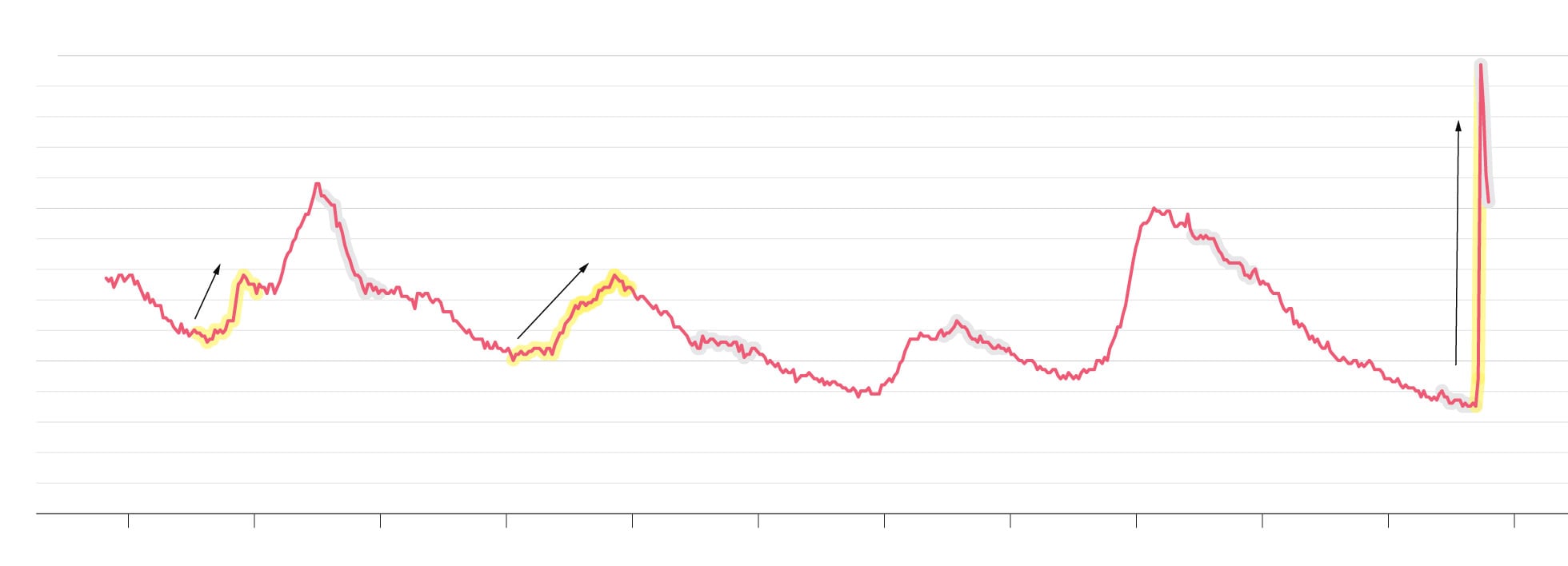
Unemployment rate before elections
The physical, psychological and economic consequences of the pandemic have altered the normal election climate. In a typical presidential race, a recession like this would probably send an incumbent packing; other issues, particularly cultural factors, would likely not matter. But Americans are still giving President Trump decent marks on his handling of the economy, and the third-quarter economic numbers could show a rapid rebound. At the same time, disagreements about immigration, political correctness and racism have kept cultural issues front and center. This mix of economic pain, the possibility of late-breaking relief, physical danger and cultural conflict makes this election unusually difficult to predict.
3
The country is seeing a months-long wave of protests, and that has made everyone more focused on race.
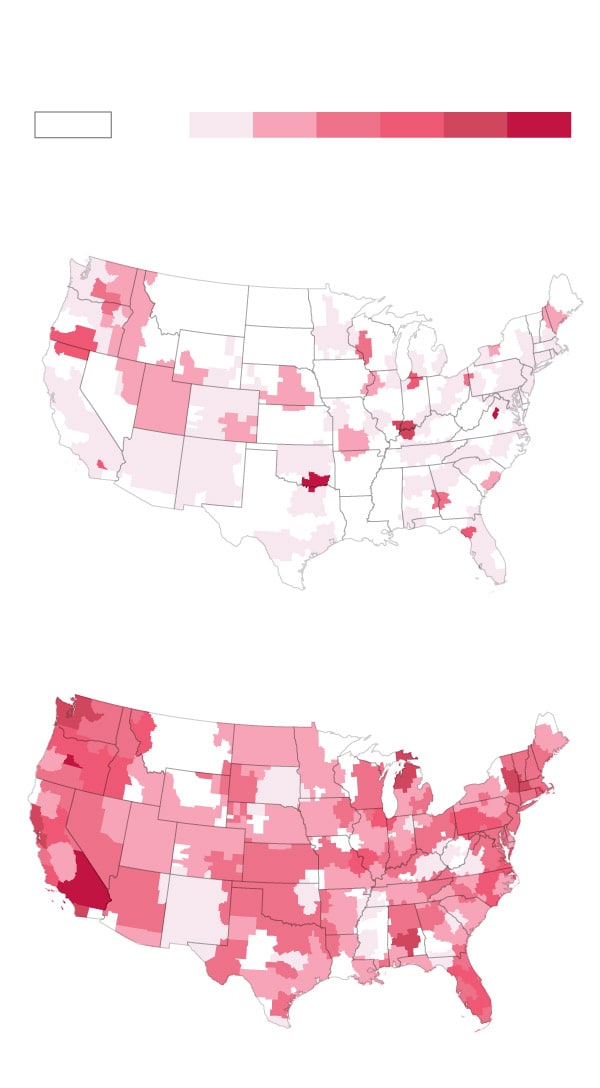
Google search volume
for “protest near me”
Negligible
January to April
May to late August
Source: Google Trends

Google search volume
for “protest near me”
Negligible
January to April
May to late August
Source: Google Trends
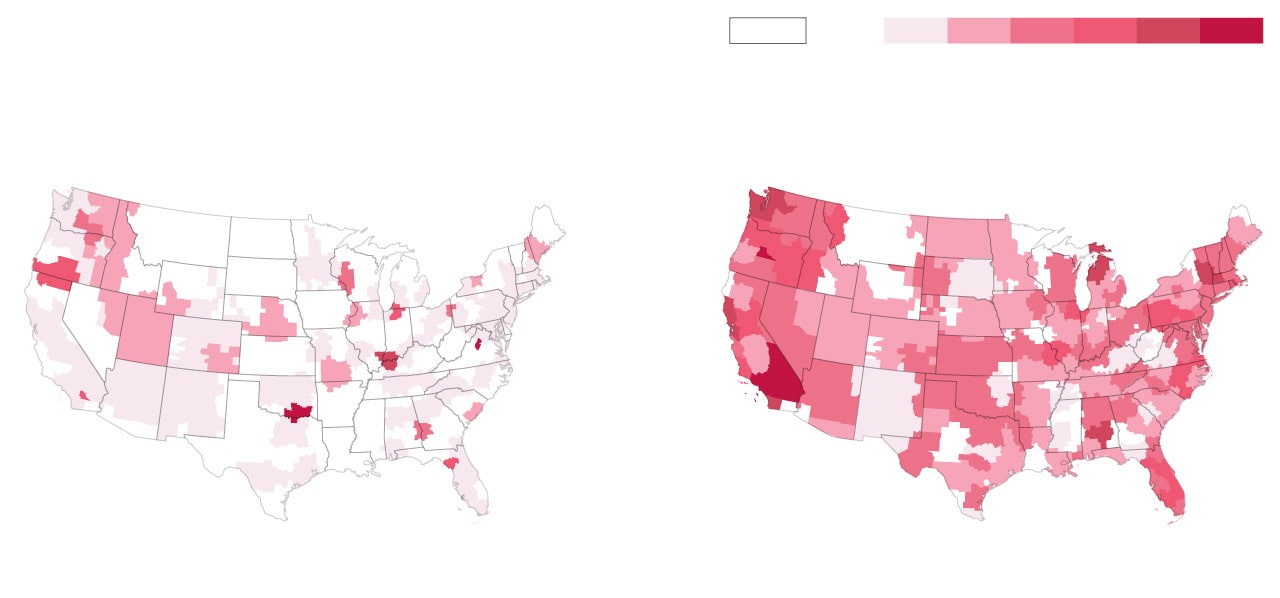
Google search volume for “protest near me”
Negligible
January to April
May to late August
Source: Google Trends
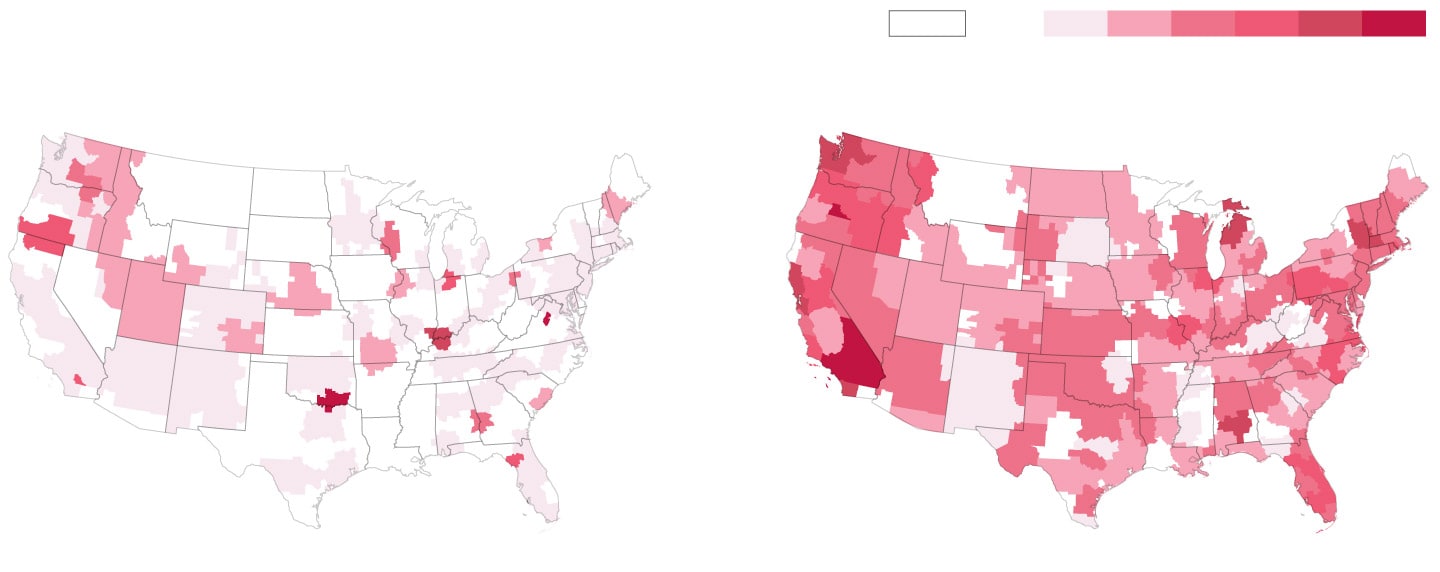
Google search volume for “protest near me”
Negligible
January to April
May to late August
Source: Google Trends
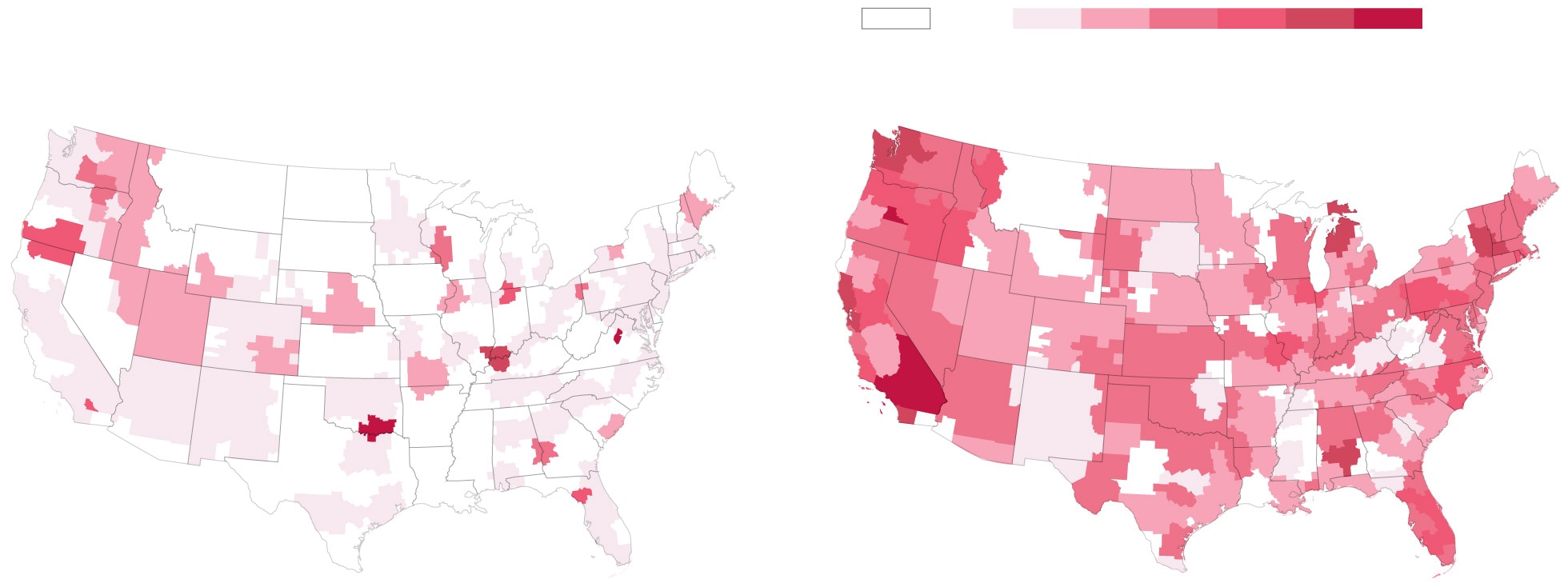
Google search volume for “protest near me”
Negligible
January to April
May to late August
Source: Google Trends
Amid the pandemic, Americans are experiencing a historic period of social unrest. The death of George Floyd at the hands of Minneapolis police fueled nationwide demonstrations against racism and police brutality, as well as associated counter-protests. Ordinarily, protests don’t garner much sympathy: Sixty percent viewed the 1963 civil rights rallies unfavorably; Occupy Wall Street had the support of only 44 percent of Americans in 2011. But according to a July Gallup poll, this movement may be the exception: Almost two-thirds supported this summer’s protests.
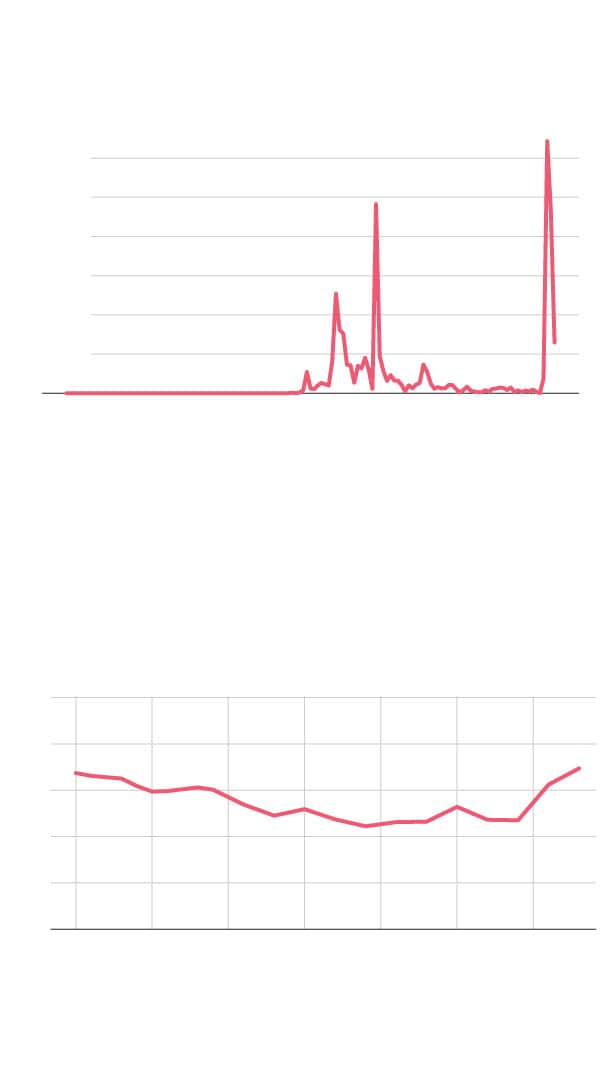
Black Lives Matter
15-second blocks mentioning Black Lives
Matter on CNN, MSNBC and Fox News
Discrimination and wealth
Percentage who agree that the racial gap
in wealth and employment is caused
by discrimination.
Sources: GDELT TV Explorer,
General Social Survey

Black Lives Matter
15-second blocks mentioning Black Lives Matter
on CNN, MSNBC and Fox News
Discrimination and wealth
Percentage who agree that the racial gap in wealth and
employment is caused by discrimination.
Sources: GDELT TV Explorer, General Social Survey
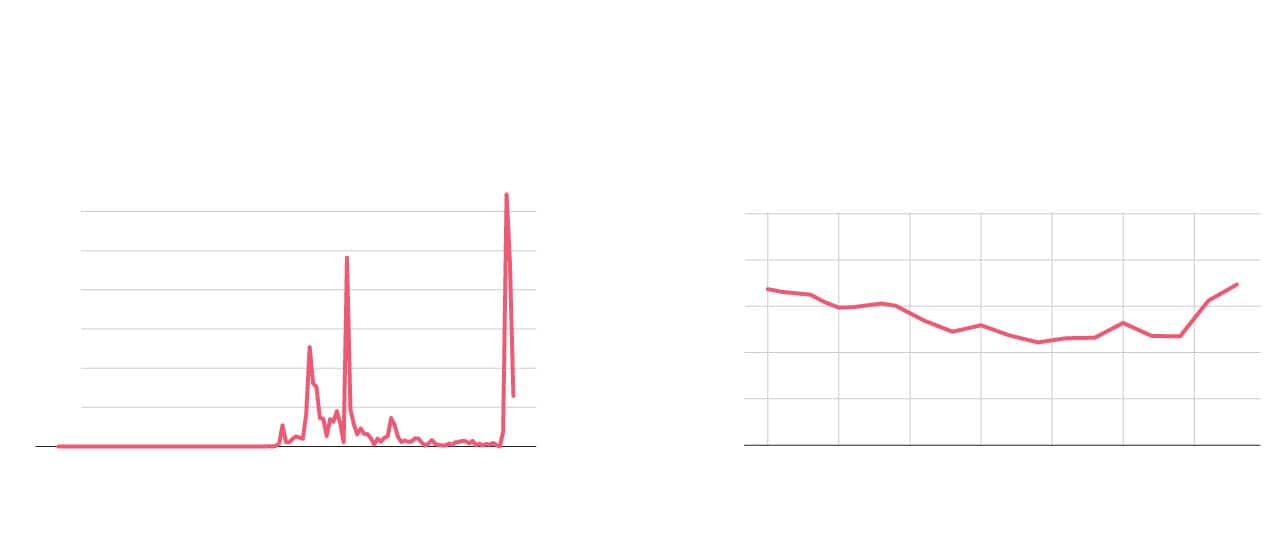
Black Lives Matter
15-second blocks mentioning
Black Lives Matter on CNN,
MSNBC and Fox News
Discrimination and wealth
Percentage who agree that the racial gap
in wealth and employment is caused
by discrimination.
Sources: GDELT TV Explorer, General Social Survey
The killings of Black men and women — and the subsequent protests — have increased awareness of racial discrimination. Over the past six years, many White voters, especially White Democrats, shifted left on racial issues as they saw the footage and read reports of police killings of Philando Castile, Eric Garner, Michael Brown and other men and women. This new understanding of police brutality and systemic racism — as well as backlash against more violent protests — is reshaping our politics, and nobody knows which trends will endure.
4
Even the most admired institutions — including the police and the military — are losing public confidence.
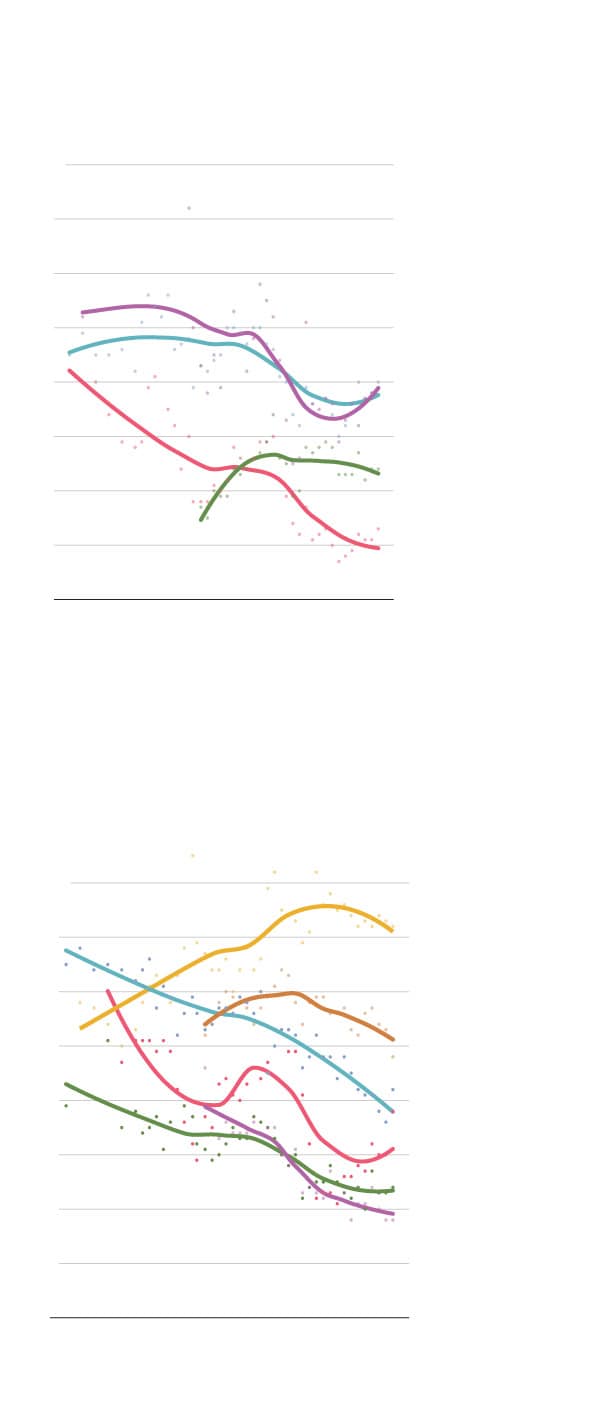
Trust in political institutions
Percentage with a great deal or
quite a lot of trust
The presidency
Supreme
court
Criminal
justice system
Trust in non−political institutions
Percentage with a great deal
or quite a lot of trust
Organized
religion
Newspapers
Source: Gallup
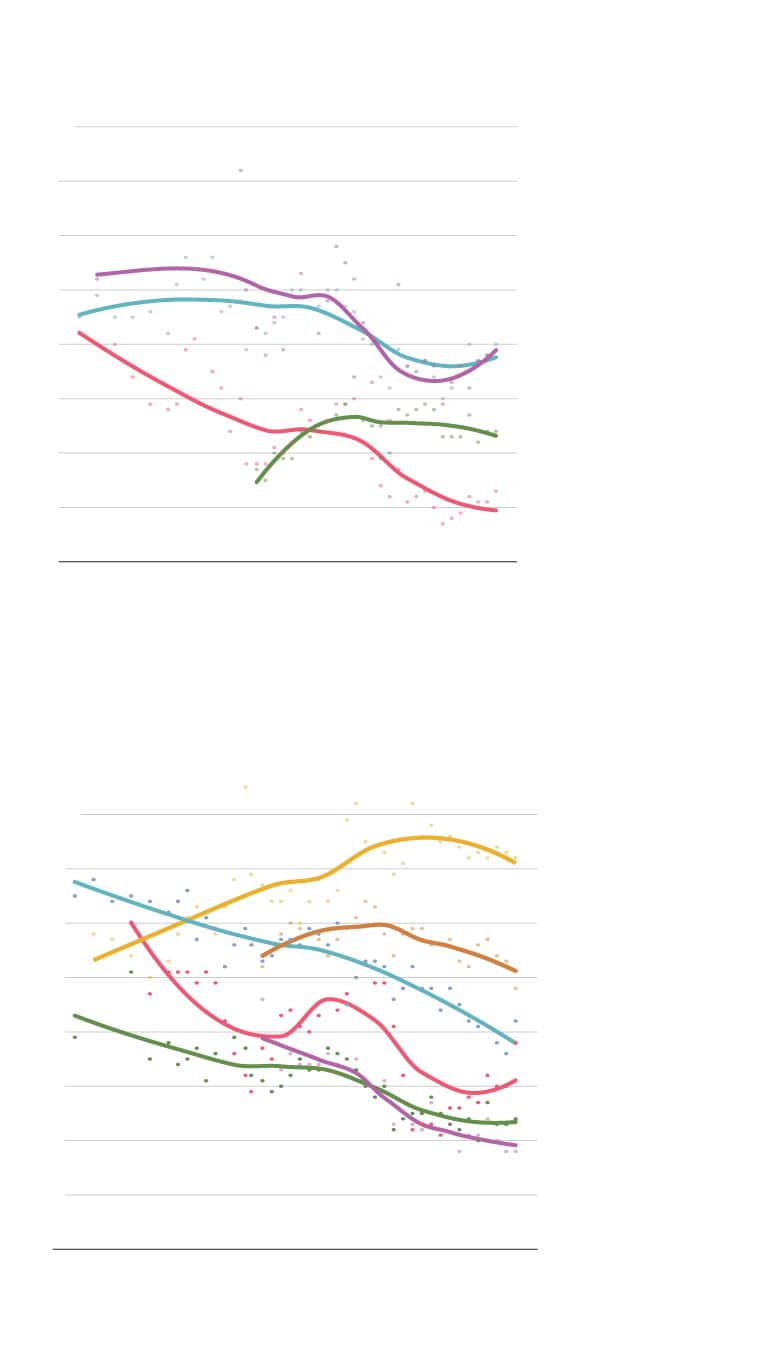
Trust in political institutions
Percentage with a great deal or quite a lot of trust
The presidency
Supreme court
Criminal justice
system
Trust in non−political institutions
Percentage with a great deal or quite a lot of trust
Organized
religion
Newspapers
Source: Gallup
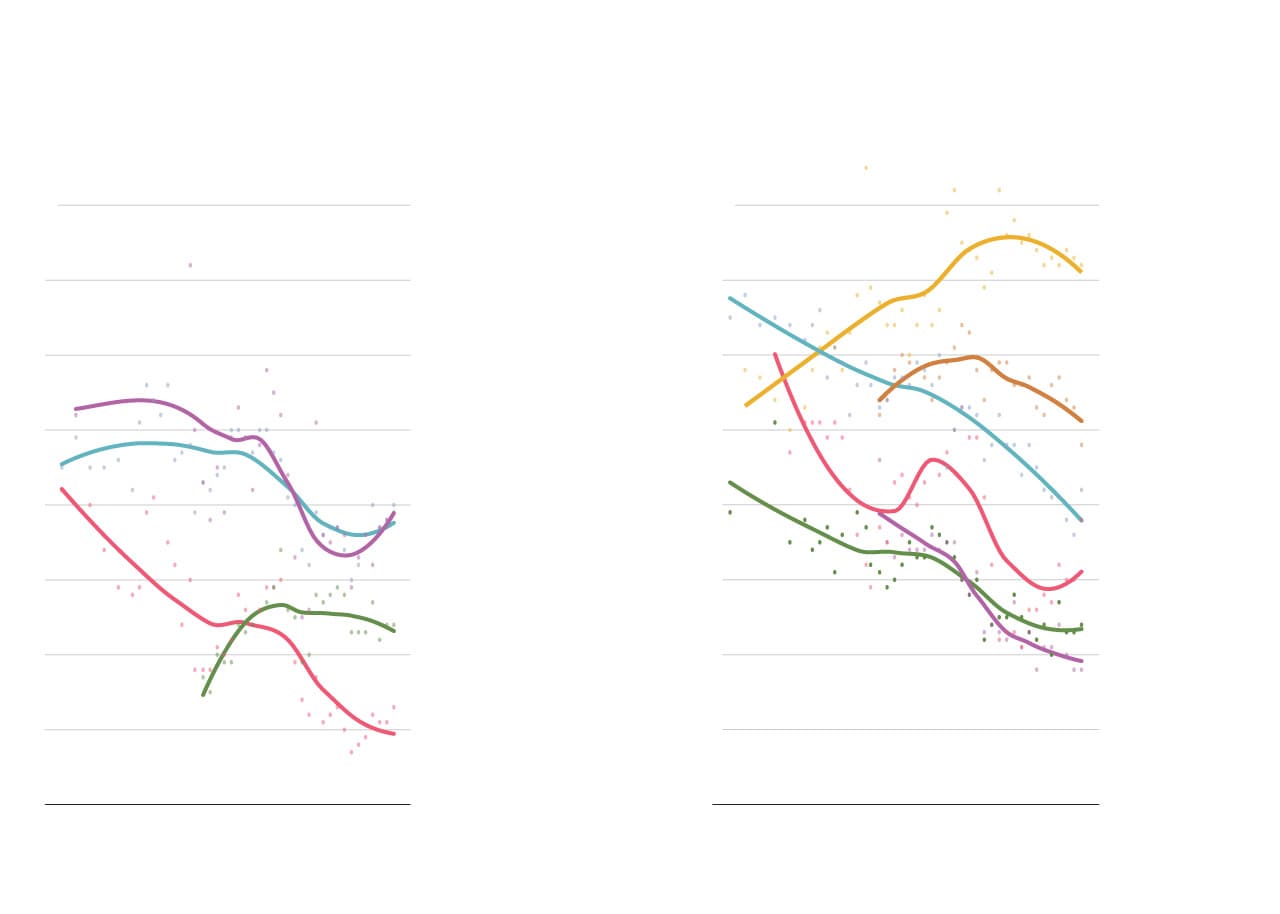
Trust in political institutions
Trust in non−political institutions
Percentage with a great deal
or quite a lot of trust
Percentage with a great deal or
quite a lot of trust
Organized
religion
The presidency
Supreme
court
Criminal justice
system
Newspapers
Source: Gallup
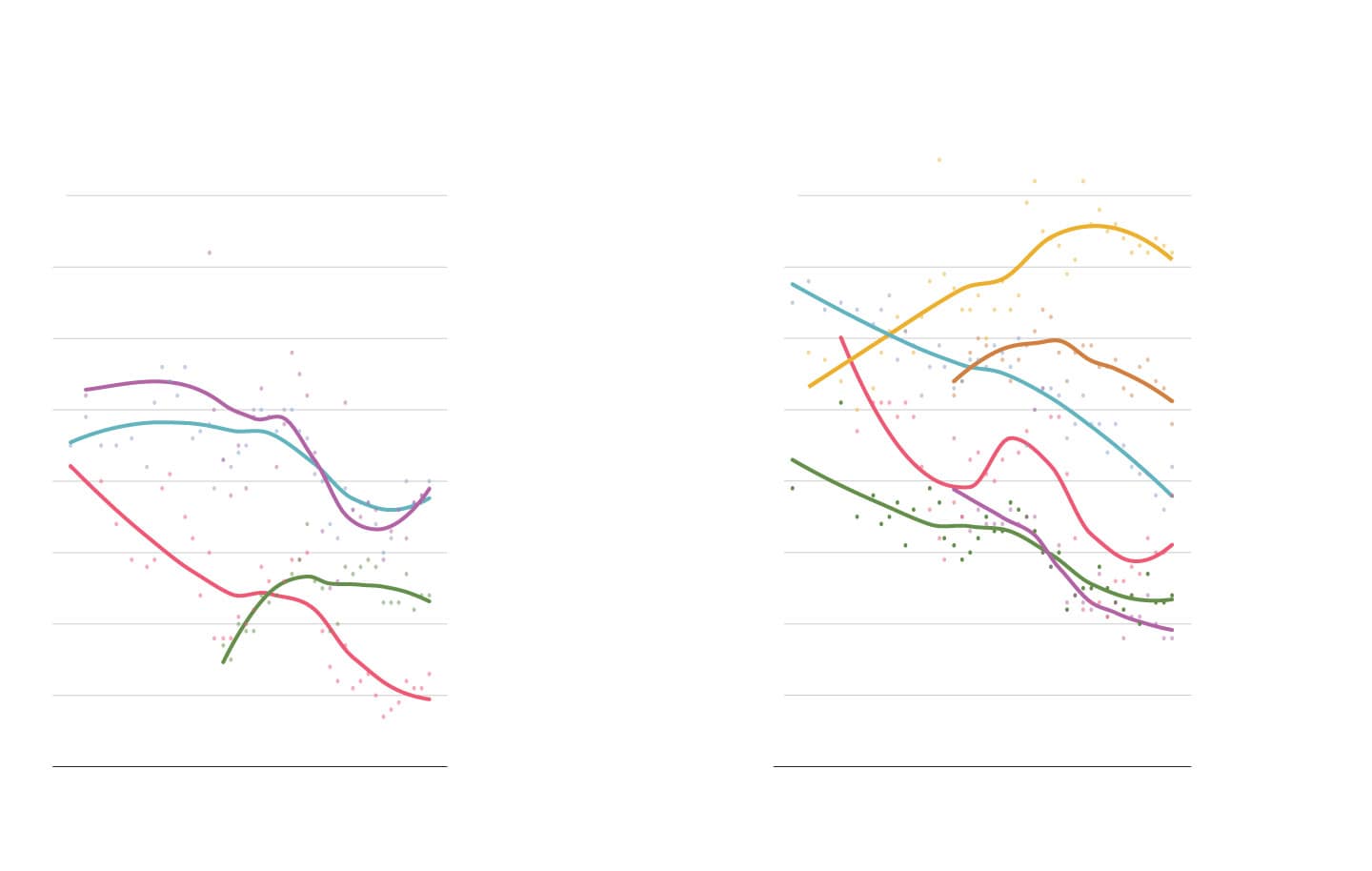
Trust in political institutions
Trust in non−political institutions
Percentage with a great deal
or quite a lot of trust
Percentage with a great deal or
quite a lot of trust
Organized
religion
The presidency
Supreme
court
Criminal justice
system
Newspapers
Source: Gallup
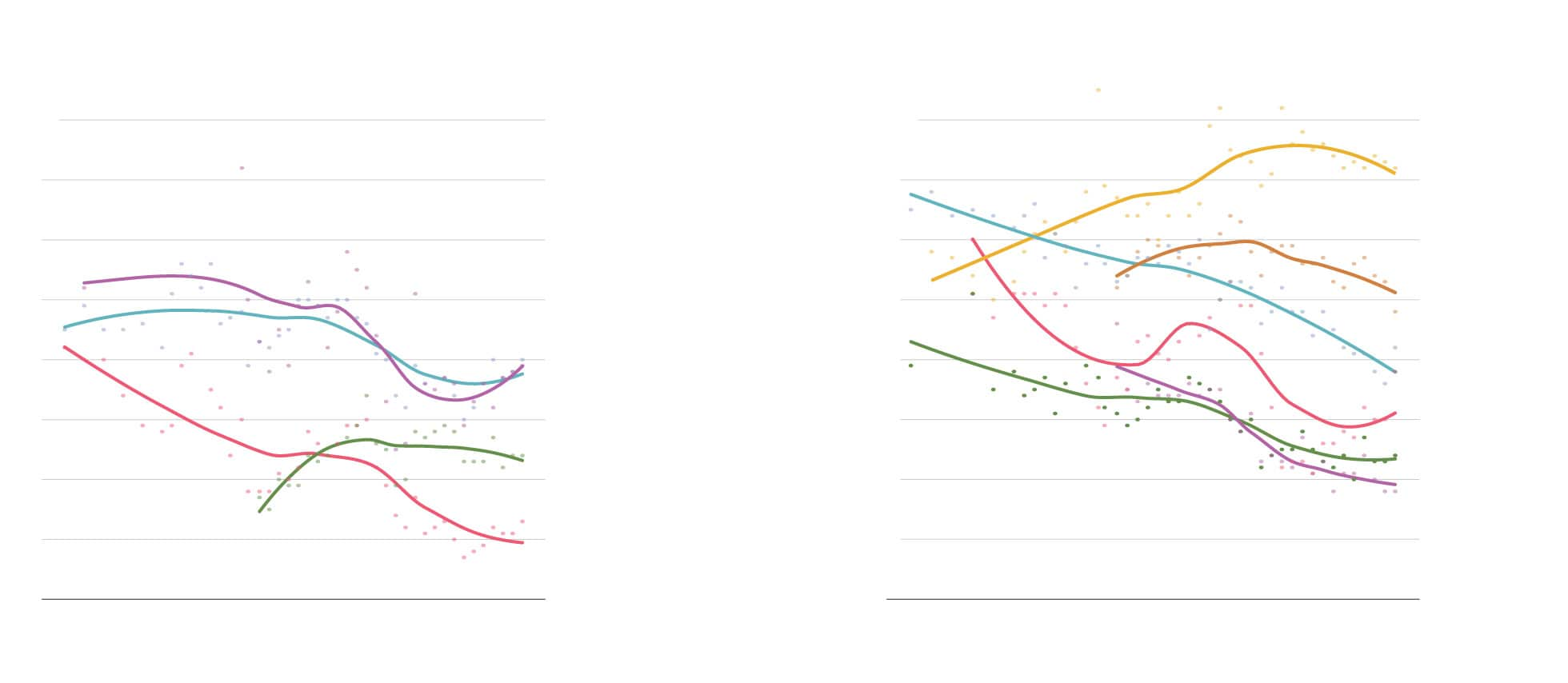
Trust in political institutions
Trust in non−political institutions
Percentage with a great deal or quite a lot of trust
Percentage with a great deal or quite a lot of trust
Organized
religion
The presidency
Supreme
court
Criminal justice
system
Newspapers
Source: Gallup
A 50-year decline in trust continues. Most Americans say they don’t trust any branch of government. Non-governmental institutions have shed credibility, too. The media is widely scorned and distrusted. Organized religion continues its long decline. Even the police and military — revered by most of the public for decades — have seen some erosion in their numbers as well. We are a country with few establishment heroes.
5
Satisfaction with the country’s direction is sagging.
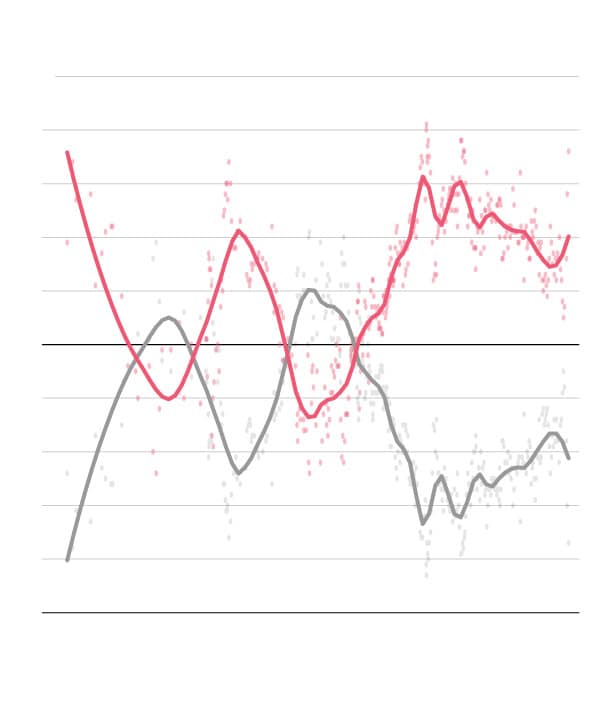
Opinion about the country’s direction
Dissatisfied
Source: Gallup
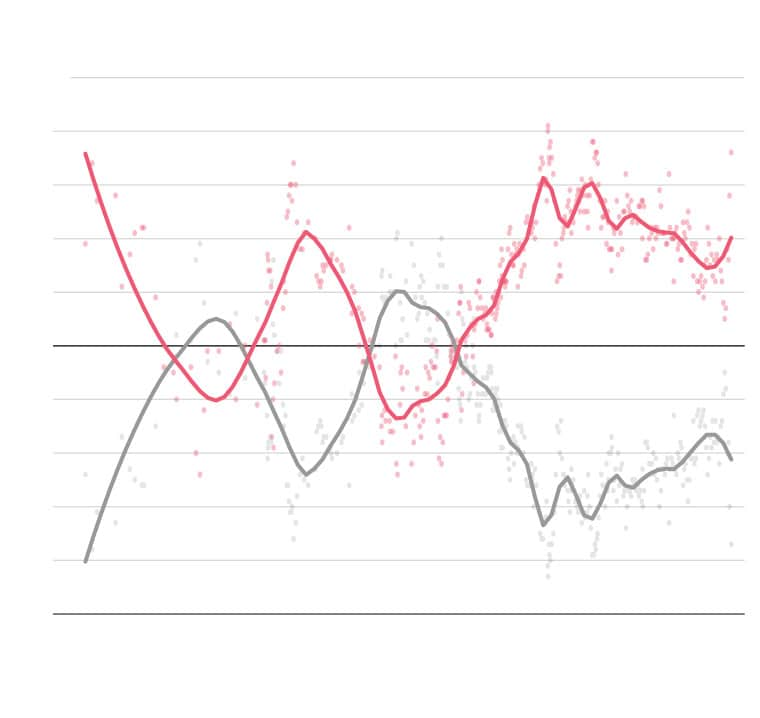
Opinion about the country’s direction
Dissatisfied
Source: Gallup
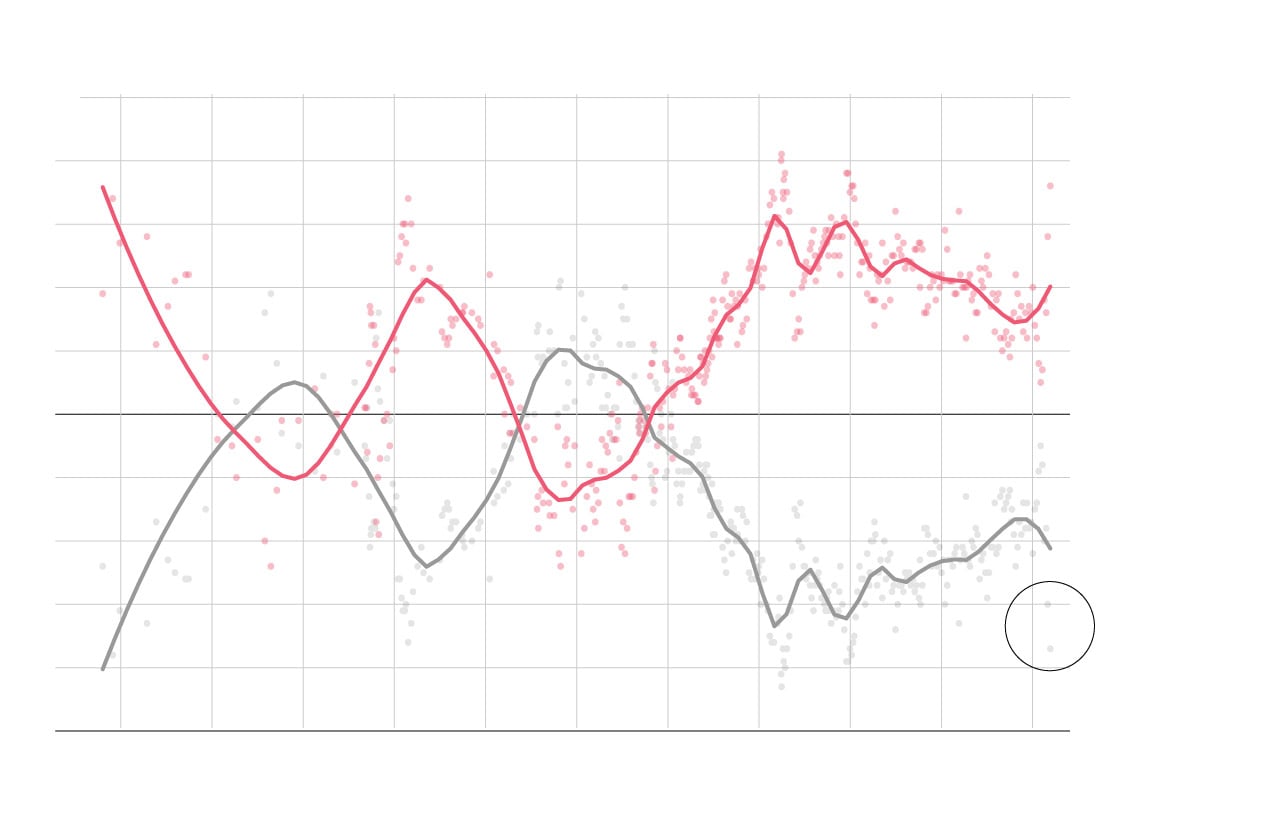
Opinion about the country’s direction
Dissatisfied
Satisfaction has plummeted during the pandemic
Source: Gallup
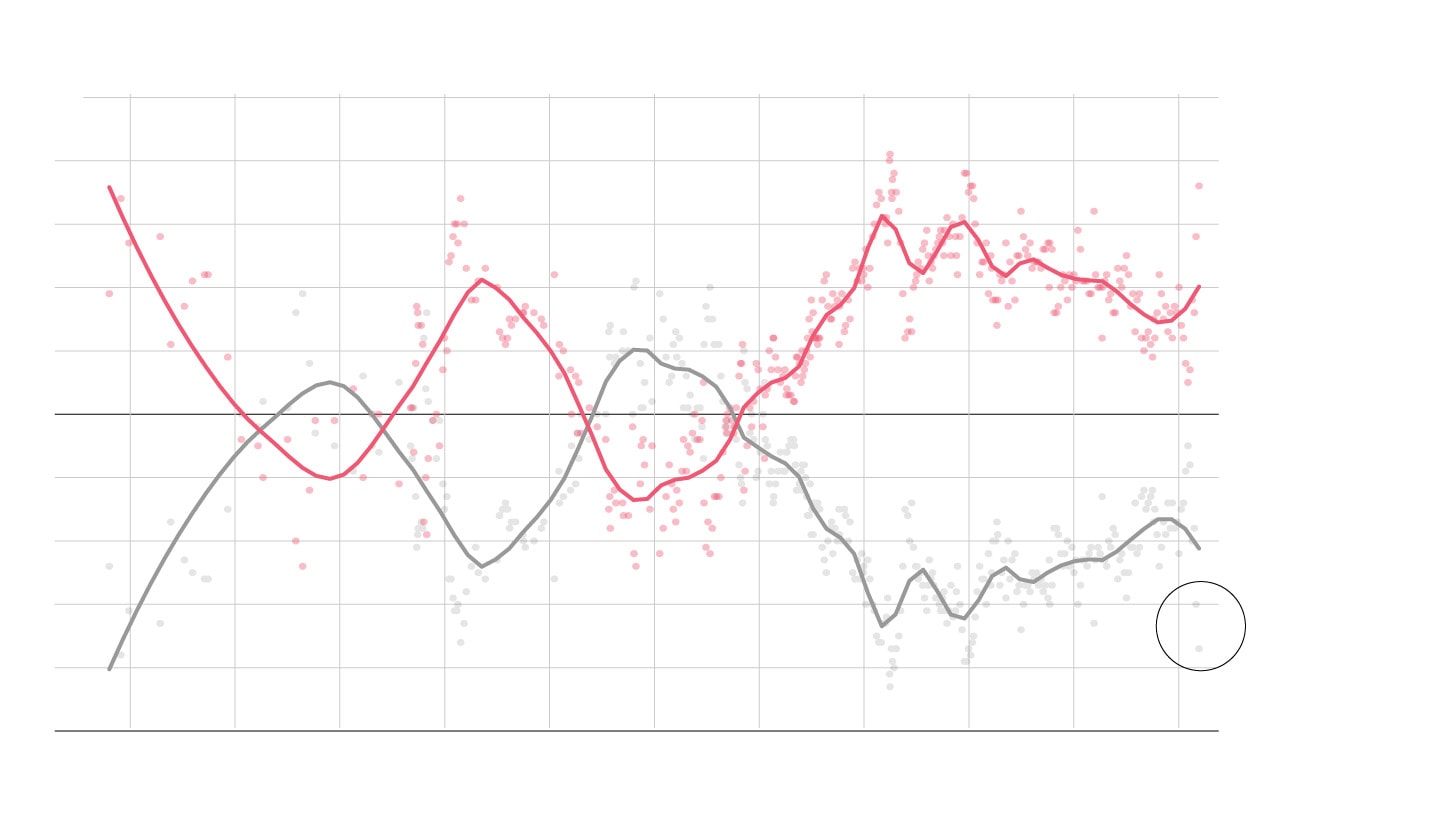
Opinion about the country’s direction
Dissatisfied
Satisfaction has plummeted during the pandemic
Source: Gallup
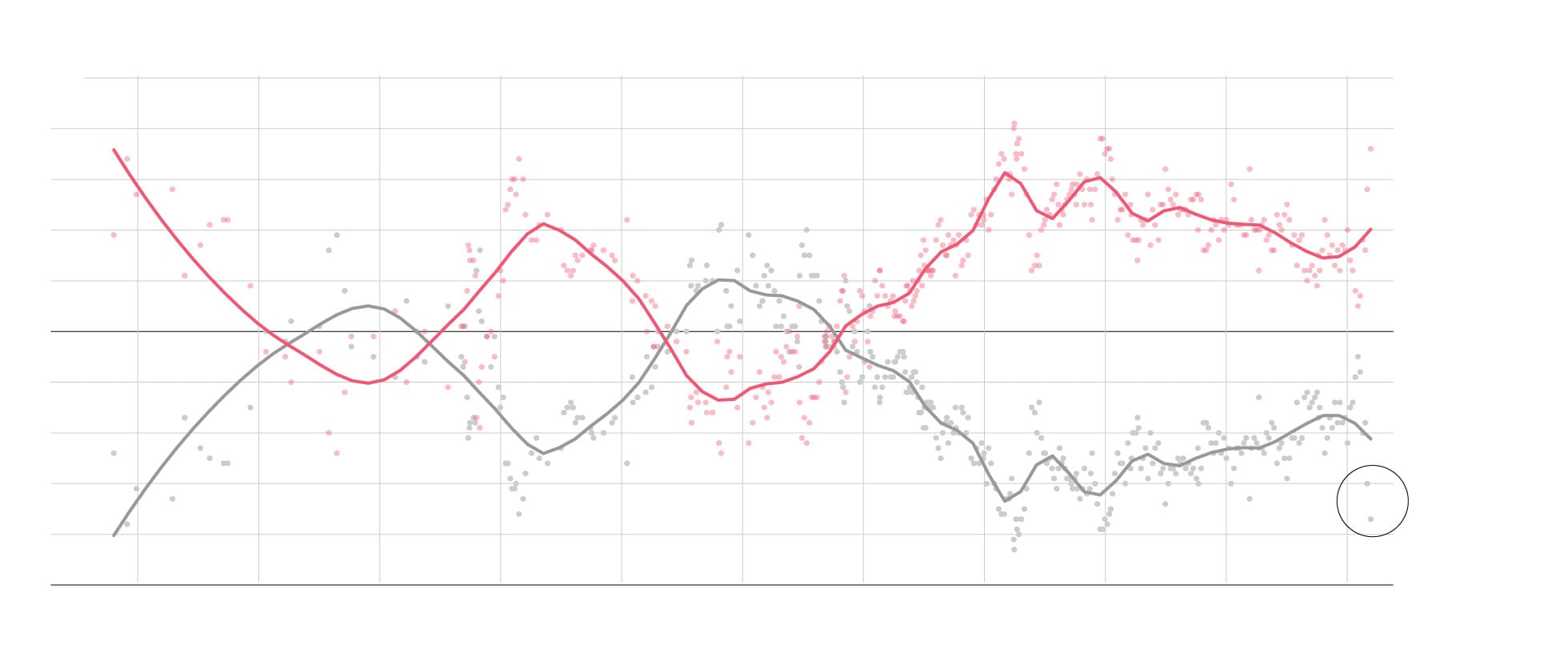
Opinion about the country’s direction
Dissatisfied
Satisfaction has plummeted during the pandemic
Source: Gallup
At the same time, Americans are disappointed in the state of the nation. In the latest Gallup poll, only 13 percent said they were “satisfied” with the direction of the country. That’s on par with earlier moments of economic agony and political conflict. Frustration with the pandemic, our institutions and institutionalized racism has united Americans in widespread discontent. It’s not clear who benefits from this unhappiness: Joe Biden could effectively seize on it, like Bill Clinton did in 1992, or fail to capitalize on it, like Mitt Romney in 2012.
6
Turnout is scrambled as the mailbox becomes the ballot box.

States that have some form of
no-excuse mail balloting
States that required an excuse
for absentee ballot in 2016
Sources: The Washington Post, Pew Research
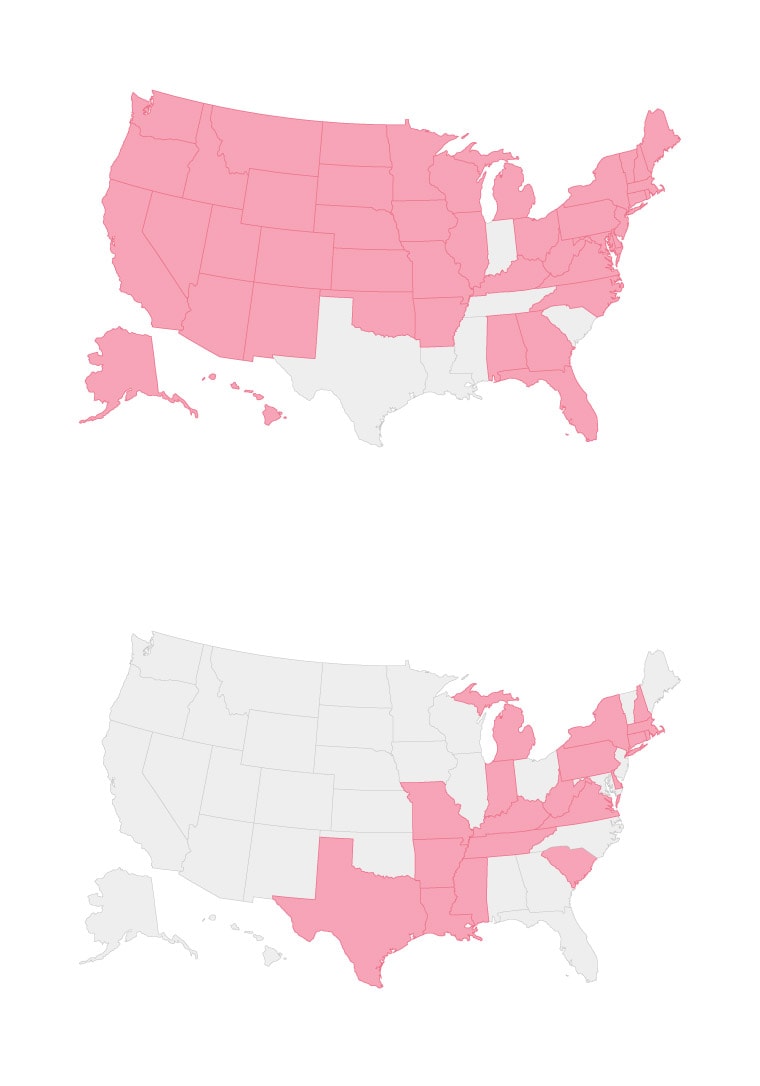
States that have some form of
no-excuse mail balloting
States that required an excuse
for absentee ballot in 2016
Sources: The Washington Post, Pew Research

States that have some form of
no-excuse mail balloting
States that required an excuse
for absentee ballot in 2016
Sources: The Washington Post, Pew Research
This election will be conducted far differently from any in the past — on Sept. 4, North Carolina will send out its first absentee ballots, and many states will quickly follow. It’s impossible to predict how many citizens will vote by mail, but a historic 83 percent of Americans will have the opportunity to do so. These changes could transform the election from a single day into a months-long slugfest of debating, voting and counting — and court challenges. That adds uncertainty, as nobody has polled a national election where so much of the vote was cast before Election Day or imagined an aftermath that could take weeks or longer to sort out.
7
Trump is underperforming his predecessors. But there’s plenty of time for the race to shift.

How Trump’s approval ratings
compare with recent presidents
Days since inauguration
Days since inauguration
Sources: Various pollsters, NYT Upshot,
RealClearPolitics, FiveThirtyEight
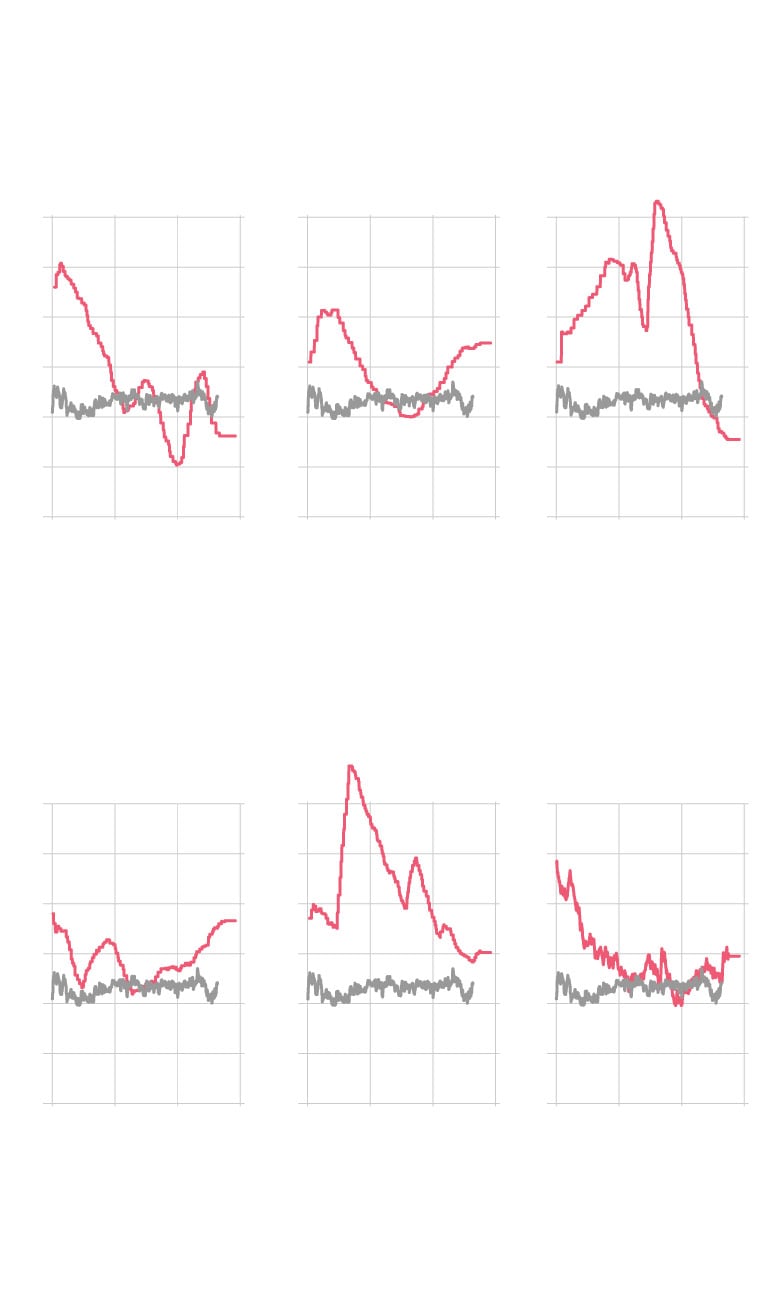
How Trump’s approval ratings compare
with recent presidents
Jimmy
Carter
Ronald
Reagan
George
H.W. Bush
Days since inauguration
Bill
Clinton
George
W. Bush
Barack
Obama
Days since inauguration
Sources: Various pollsters, NYT Upshot, RealClearPolitics,
FiveThirtyEight

How Trump’s approval ratings compare with recent presidents
Jimmy Carter
Ronald Reagan
George H.W. Bush
Days since inauguration
Bill Clinton
George W. Bush
Barack Obama
Days since inauguration
Sources: Various pollsters, NYT Upshot, RealClearPolitics, FiveThirtyEight
For most of the past three years, the president’s approval rating has hovered in the low-40 percent range. But Trump won with weak numbers before. At this time in 2016, fewer than 40 percent of voters viewed him favorably. Today, he enjoys the irreducible support of 4 in every 10 voters. Biden is personally much more popular than Hillary Clinton was; Trump is having trouble winning over voters who disapprove of him personally.

National polling average on
previous presidential elections
150
Days until election
150
Days until election
Sources: Various pollsters, FiveThirtyEight,
RealClearPolitics

National polling average on
previous presidential elections
150
Days until election
150
Days until election
Sources: Various pollsters, FiveThirtyEight, RealClearPolitics

National polling average on previous presidential elections
Days until election
Days until election
Sources: Various pollsters, FiveThirtyEight, RealClearPolitics
The basic math is simple: Voters don’t like how Trump is handling the coronavirus pandemic; they dislike how he deals with racial issues; and his popularity on economic issues isn’t yet translating into enough votes to win. But presidential contests have shifted dramatically after Labor Day over the past generation. What looks certain on Aug. 1 is often long forgotten by Oct. 1. And none would argue, after the past few elections, that polls are perfect.
Everything about 2020 has been unimaginable so far. Why would we expect that to change now?
[Sign up for The Odds newsletter for election updates from data columnist David Byler]
Watch Opinions videos:
More from Opinions:
David Byler: A tiny change in the electoral math could blow up Joe Biden’s campaign
Jennifer Rubin: Trump has the narrowest base ever. Biden has the broadest.
Jonathan Capehart: Trump keeps walking into Joe Biden’s trap
Eugene Robinson: Scared that Trump can come back to beat Biden? Good.
Michael Gerson: It’s obscene to focus on how violence affects the vote. But it is our reality.
David Byler: The DNC is over. Here’s how to read the post-convention data.






